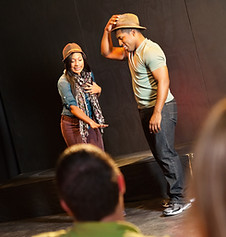
Vocabulary Development is a crucial part of children's development. Children will learn vocabulary early on and will continue to learn words of all sorts of contexts and meanings. There are many ways to teach vocabulary and it's important to understand when to teach what words and how to teach them. There are many strategies that you can use to aide in vocabulary development. Scroll down for more information.


Effective Steps for Teaching Vocabulary Directly
There are many effective steps for teaching vocabulary development. Wright suggests the following six steps:
" 1. Provide a description, explanation, or example of the new term (along with non linguistic representations such as pictures.
2. Ask students to restate the description, explanation, or example in their own words.
3. Ask students to construct a picture, symbol, or graphic representing the term or phrase.
4. Engage students periodically in activities that help them add to their knowledge of the terms in their notebooks.
5. Periodically ask students to discuss the terms with one another.
6. Involve students periodically in games that allow them to play with terms." (Wright, Pg. 161).
Words Worth Teaching
There are three tiers of vocabulary and education. Vocabulary is usually taught through direct instruction by teachers and by others. Vocabulary is super important for reading comprehension and the development of language. Students normally have a vocabulary of about 6,000 words by first grade and will continue to learn half of that each year they are in school. A good question is how do you determine which words are worth teaching?
Tier 1 consists of the most basic words. These words usually only have one meaning and are not usually directly taught to the student. A great example of tier 1 words are sight words.
Tier 2 consists of words that are seen in many different contexts. These words contain multiple meanings and are key to being successful for reading comprehension.
Tier 3 consists of words that are low frequency and used in specific contexts. These words are usually taught when learning about a specific subject and words that are needed to describe or define topics in that context. (Hutton)

The examples used in this diagram are adapted from the handout "Three Tiers of Vocabulary and Education." (See citations)

Three Activities Teachers Could Use to Teach Vocabulary
Word Wizard Box
For this activity, students would be encouraged to listen for new vocabulary words at home and write 3-4 of them on separate pieces of paper. They would then fold the papers up and put them into a box. The teacher shakes the box up and allows a student to pull one piece of paper. The teacher then reads the word, works with the class to come up with a definition, then asks the student who wrote it to talk about where they heard that word and in what context. They then repeat this process and bring new words. Words can be posted on a word wall or added into vocabulary journals.
(Adapted from https://www.readingrockets.org/article/vocabulary-development-ells)
Classroom Labels in English and Spanish
For this activity, teachers would label various classroom materials and parts to the classroom in both English and Spanish or a student's Native Language. This would help them see the word in their language as well as the language they are trying to learn. This makes me think about the various readings we have read about how building on a student's L1 will help them develop L2 better and become more successful with it.
(adapted from https://www.readingrockets.org/article/vocabulary-development-ells)

Vocabulary Improv
For this activity, students will come up with their own motions to represent different vocabulary words. This is helpful because it gets students involved in kinesthetic learning and they are more likely to memorize the new vocabulary words when they are connected with a specific motion.
Citations
Michaela Colombo. (2012). Teaching English Language Learners : 43 Strategies for Successful K-8 Classrooms. SAGE Publications, Inc.
Wright, W. E. (2019). Listening and Speaking. In Foundations for teaching English language learners: Research, theory, policy, and practice. Philadelphia: Caslon.
Hutton, Thaashida. (N.D). Three Tiers of Vocabulary and Education. Super Duper Publications. Number 182.